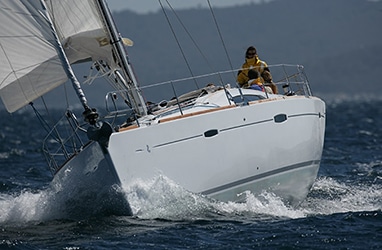
This article is an excerpt from NauticEd’s online FREE Navigation Rules Course, an interactive online sailing course for ALL sailors to learn Navigation Rules and become a safer sailor. Or if you want to learn more, upgrade to the Skipper Course Bundle to become a competent sailor!
You can learn to sail and improve your sailing with NauticEd, the international leader in sailing education.
Sailboats vs Sailboats Nav Rules
Sailboats On The Same Tack
The Rule
12 a(ii) when both have the wind on the same side, the vessel which is to windward shall keep out of the way of the vessel which is to leeward;
Examples
Several Scenarios are presented below as same tack Give-Way examples:
This video shows a windward boat approaching from the upper left of the screen whilst the leeward boat is approaching from the bottom left. Both sailboats are on port tacks. Quickly analyze and announce (to yourself) who must give way.
Now can you figure out this scenario?
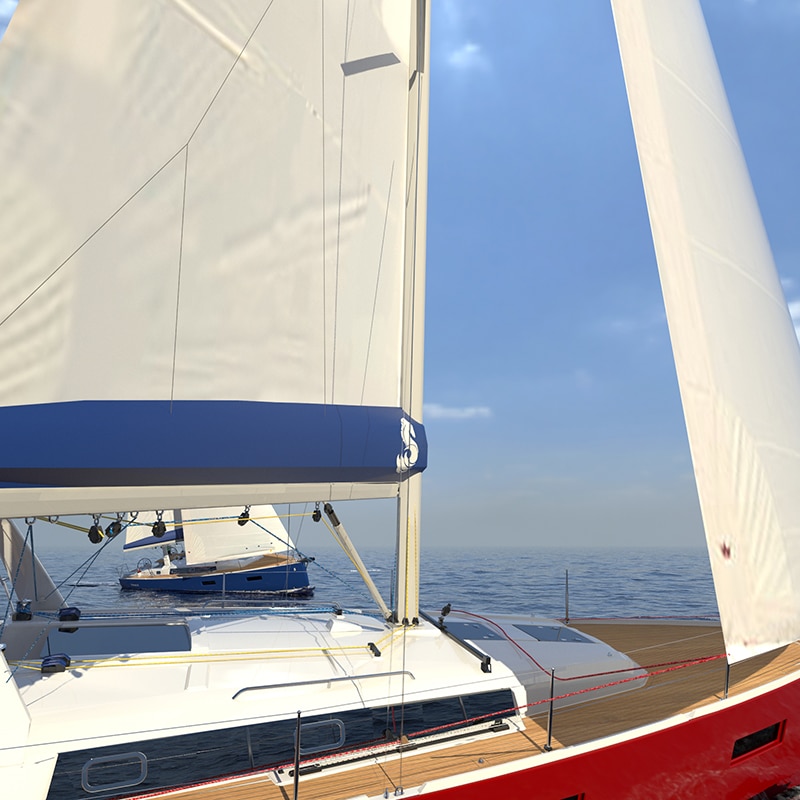
The boat you are standing on is on port tack because you can see the headsail is being blown to the starboard side of the boat. The boat approaching is also on a port tack since you can also see that their headsail is on their starboard side. Under this scenario you are further downwind and the leeward boat. Therefore, they must Give Way. Caution however, their sails may be blocking their view of you and therefore, it is prudent to hail “LEEWARD”.
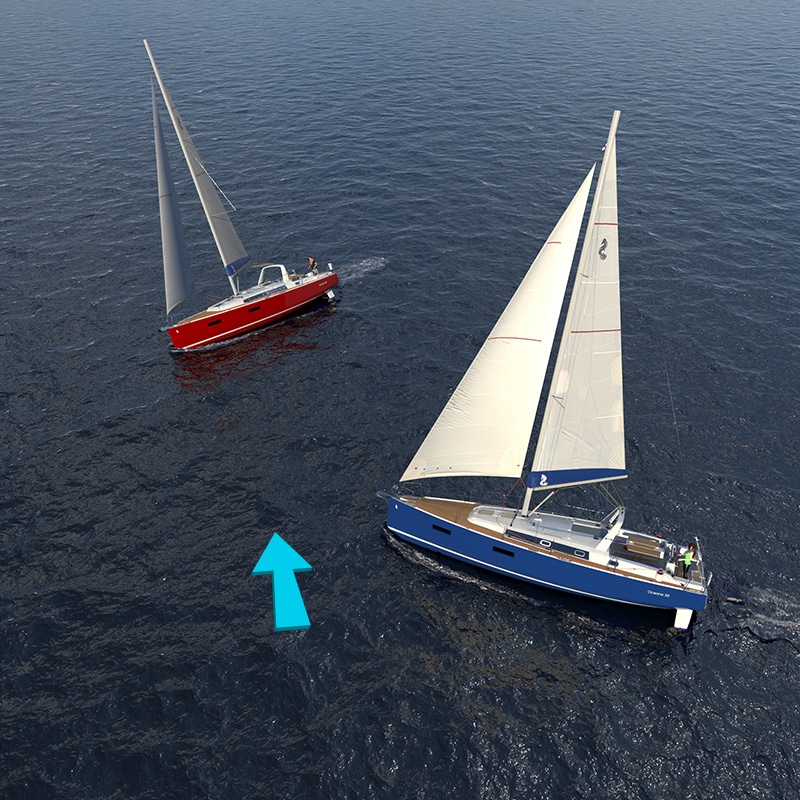
Above: From the set of the sails, the wind is obviously from bottom to top in the image. Therefore, Blue is on Port, Red is also on Port. Red is the leeward boat and therefore is the stand-on vessel. Thus, Blue must give way and be in a hurry from the looks of it. The best action here would be for Blue to steer up into the wind – turn to port – NOW! However, every circumstance is different and a “judgment call”. The reason we’d recommend an immediate turn to port for Blue is because it would be turning away from Red. Trying to duck (going behind) is risky because you are turning towards Red and depending on your speed you could hit Red. A turn to port will allow Red to give room without any risk of collision.
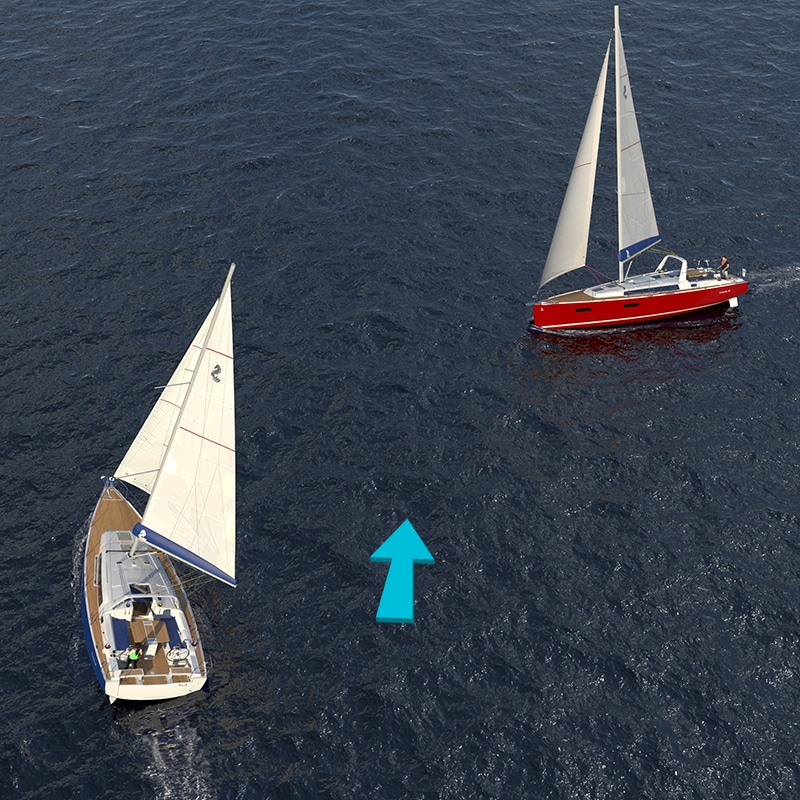
Above: Again from the set of the sails, the wind is coming from the bottom left to the top right on the image and Red and Blue are both on Port. Red is the leeward boat. Blue must Give Way. The best course of action would probably be to turn upwind and tighten sails, although a gybe would work as well depending on Blue’s desired course and taking into account that in high winds, gybes are dangerous for the crew and for the rig.
Sailboats on Opposite Tacks
The Rule
12(a) (i) when each has the wind on a different side, the vessel which has the wind on the port side shall keep out of the way of the other
Instead of trying to figure that out, here is an experiential animation that shows what you should do from the perspective of being the skipper on your own boat.
Discussion
In olden times the steerboard (rudder) was mounted typically on the right side of the boat. In order to prevent damage to the steerboard a boat would dock its left side to the dock (port). Thus via language, accents, and time boat sides became referred to as starboard and port. When a boat was sailing with the wind coming first over its right side the boat is said to be on a starboard tack. It thus heels to port. With the heeling effect this meant that a boat with its rudder mounted to the starboard side of the boat, it would have less of its rudder in the water. This would make the boat less maneuverable than boats on the opposite tack that had their full rudder length in the water. And so became the convention of port tack (more maneuverable) boats must Give-Way to starboard tack (less maneuverable) boats. Now virtually all boats have their rudder in the center. However, the convention has held steadfast.
At all times you must know what tack you are on and constantly be assessing what tack other boats around you are on. The rule also states that if a vessel with the wind on the port side sees a vessel to windward and cannot determine with certainty whether the other vessel has the wind on the port or on the starboard side, she shall keep out of the way of the other.
Note that you don’t mix the rules of: on the same tack, and on opposite tacks. Meaning that if you are on a starboard tack (wind coming from starboard side of your boat) but there is a possible close-quarter situation with a boat on a port tack (wind coming from the port side of that boat) and that boat is to leeward, then there is no confusion. Clearly, you are on opposite tacks -you have the wind on different sides – see 12(a) (i) above. 12(a) (ii) does not apply.
Examples
In the video below, you can see two sailboats on a collision course. The sailboat on a port tack correctly changes course to avoid the sailboat on a starboard tack. The port tack boat also could have turned to starboard to duck in behind the other boat. However, in this case, it chose to tack. The decision to tack or duck is up to you but make your decision early.
Here are two more static examples: In this first case, red is on starboard (wind comes from the starboard side of red’s boat) and blue is on port (wind comes from the port side of blue’s boat). Blue must give way because of Rule 12(a)(i). You might say that Blue is too leeward of red, but that does not apply – they are on opposite tacks. Port tack always gives way to starboard in a crossing situation.
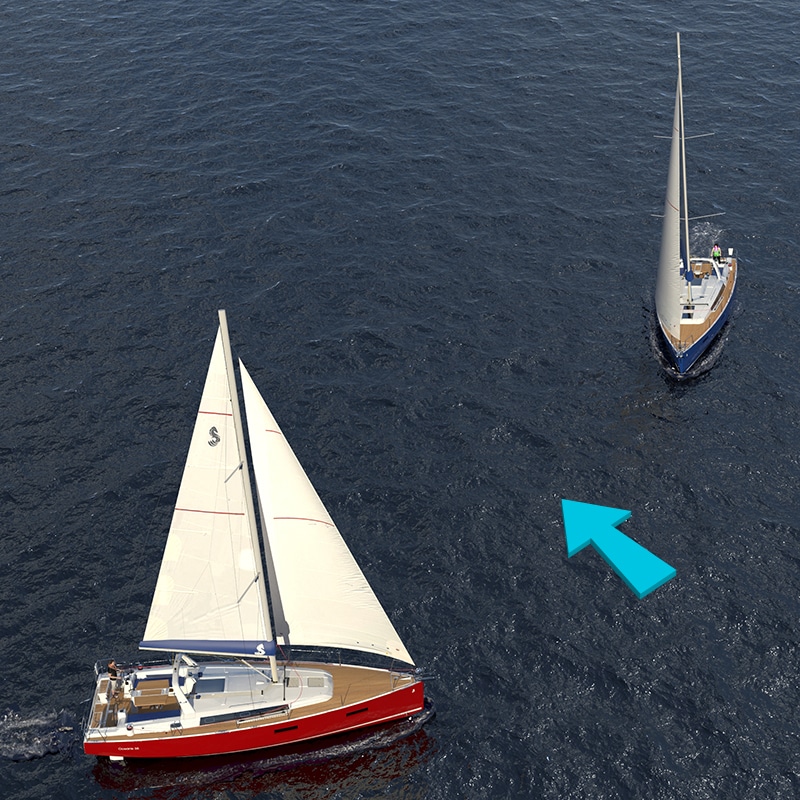
Action: Blue could release sails and turn to starboard (downwind) or turn to port and tack. Either action had better be NOW! We’d estimate here that Blue is better off letting sails out and bearing away from the wind to pass behind Red. It is probably too late to tack because of the forward momentum of the vessel. Also of note, if Red were to take evasive maneuvers to avoid Blue, Red should tack, turning to starboard. i.e. evasive maneuvers should always be in the direction away from the vessel and in a direction that would not cause a collision should the other vessel make last-second maneuvers. In this example, if Red turns to starboard, the chance of collision would be significantly reduced.

Above: From the set of the sails the wind must be blowing from top left to bottom right on the image. Therefore, Blue is “on starboard” and Red is “on port”. Red must Give-Way. The best course of action would probably be for Red to turn further downwind to starboard – perhaps even causing a gybe.
Unsure
Especially at night, but also many times when viewing a sailing vessel you might be unsure about its tack. Well, the rules cover this also.
12(a) (iii) if a vessel with the wind on the port side sees a vessel to windward and cannot determine with certainty whether the other vessel has the wind on the port or on the starboard side, she shall keep out of the way of the other
Running
The Rules also cover running directly downwind where the wind is directly abaft and not coming over either side of the sailboat.
12(b) For the purposes of this Rule the windward side shall be deemed to be the side opposite that on which the mainsail is carried or, in the case of a square-rigged vessel, the side opposite to that on which the largest fore-and-aft sail is carried.
Discussion
The two boats below are Running. The forward boat is on port. The rear boat is on starboard.

One Sailboat Overtaking Another
When one sailboat is overtaking another sailboat we refer you to the next page which discusses Rule 13 overtaking. This overtaking rule seems like it could be a contradiction, in certain circumstances but it is not. Rule 13 is the overriding rule, it takes precedence over the other rules.
For example, when a sailboat on starboard is overtaking a sailboat on port – it is the starboard sailboat that must Give-Way not the port sailboat. See the next page for examples and discussion.
Learn Navigation Rules for Free...
A FREE 3-hour course that teaches how to stay safe, avoid collisions and accidents, and learn the “Rules of the Road”. The free Navigation Rules Course is for ALL sailors, whether you’re just learning or need a FREE refresher. Or, consider upgrading to the Skipper Course Bundle to become a fully competent skipper!
